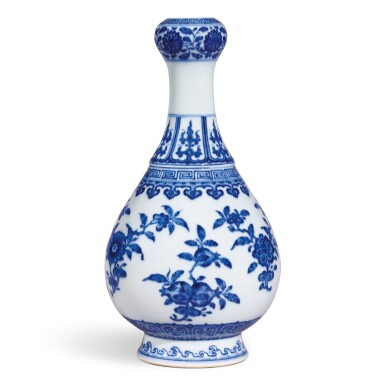Important Chinese Art
Important Chinese Art

PROPERTY OF A GENTLEMAN 士紳珍藏
A BLUE AND WHITE GARLIC-MOUTH VASE SEAL MARK AND PERIOD OF QIANLONG | 清乾隆 青花折枝花果紋蒜頭瓶 《大清乾隆年製》款
Auction Closed
October 9, 08:09 AM GMT
Estimate
2,000,000 - 2,500,000 HKD
Lot Details
Description
Property of a Gentleman
A BLUE AND WHITE GARLIC-MOUTH VASE
SEAL MARK AND PERIOD OF QIANLONG
清乾隆 青花折枝花果紋蒜頭瓶
《大清乾隆年製》款
the body painted with alternating flowering and fruiting branches of the sanduo arranged in two registers above borders of lappets and crested waves, the neck with pendent lappets enclosing double-trefoil motifs above a key-fret band and ruyi heads, the mouth with a floral scroll below a further key-fret frieze, the base inscribed with a six-character seal mark, wood stand
27 cm, 10 ⅞ in.
Collection of T.T. Tsui (1940-2010), The Tsui Museum of Art, Hong Kong.
徐展堂(1940-2010年)收藏,香港徐氏藝術館
Elegantly shaped with smoothly sloping shoulders and elongated neck, suantouping or ‘garlic-mouth’ vases are among the most interesting vessel shapes of Chinese porcelain. The form, featuring a distinctive bulbous mouth in the shape of a garlic fruit, was popular in the Ming and Qing dynasties. Generally, imperial porcelain vases during the Qing period were manufactured for decorative purposes or as flower vases. Suantouping, with their typical narrow mouth, would be suited to hold one flower or a single fruiting branch, which would match one of those depicted on the vase. Fired at the imperial kilns at Jingdezhen, this attractive design is beautifully rendered, successfully displaying the mottled ‘heaped and piled’ effect of the most desirable of early Ming period blue-and-white porcelains. The Qianlong Emperor is known to have commissioned close copies of early Ming porcelains at the imperial kilns at Jingdezhen. Although there appears to be no exact prototype of this kind of suantouping from the early Ming period, its design of individual fruiting branches is seen on ceramic wares as early as the Yongle reign. The Yongle prototypes are painted with six or ten fruiting sprigs, varying in size and border decoration, as seen on a meiping in the Palace Museum, Beijing, illustrated in Zhongguo taoci quanji [Complete series on Chinese ceramics], Shanghai, 1999-2000, vol. 12, pl. 12. At that time, the design was mostly used on vases, although bowls, however rare, are also known, such as the bowl sold in these rooms, 7th October 2015, lot 3606.
After the Yongle period, the ‘fruiting branch’ design, celebrating auspicious wishes for longevity and prosperity, continued to be popular on imperial wares, but then mainly on bowls and less on vases. Compare, for example, a Xuande bowl of conical shape, illustrated in Regina Krahl, Chinese Ceramics from the Meiyintang Collection, London, 1994-2010, vol. 2, pl. 671. In the Qing dynasty, this design re-appears on vases.
The origin of the ‘garlic-mouth’ as a decorative element, is uncertain, but the vessel itself is modelled after an archaic bronze wine vessel named hu with a mouth distinctively formed of garlic cloves, see Jenny So, Eastern Zhou Ritual Bronzes from the Arthur M. Sackler Collections, New York, 1995, no. 52, where the hu is attributed to the late Eastern Zhou, late Warring States period, 4th-3rd century BC. The bronze hu equally features a slightly flaring ring foot, but a shorter, rounder body and a longer neck. In its shape, the suantouping of the Ming period tends to be closer to the bronze prototype than the Qing variant, which is much more elegantly shaped and better adapted to Qing court taste.
‘Garlic-mouth’ vases of this design were first produced in the Yongzheng reign, such as a vase sold in these rooms, 29th November 1978, lot 234. They continued to be popular throughout the Qing dynasty; compare a Jiaqing version in the Palace Museum, Beijing, illustrated in The Complete Collection of Treasures of the Palace Museum. Blue and White Porcelain with Underglazed Red (III), Hong Kong, 2000, pl. 145; and a Daoguang example, included in the exhibition Imperial Porcelain of Late Qing, The Chinese University of Hong Kong, Hong Kong, 1983, cat. no. 1, from the Simon Kwan collection.
Closely related vases with Qianlong mark and of the period are in several museums: in the National Palace Museum, Taipei, illustrated in Gugong cang ci. Qing qinghua ci/Porcelain of the National Palace Museum. Blue and White Ware of the Ch’ing Dynasty, Hong Kong, 1968, vol. 2, pls 5a-c; in the Capital Museum, Beijing, published in Zhongguo gu taoci quanji [Complete series on Chinese ceramics], Shanghai, 1999-2000, vol. 15, pl. 8; in the Nanjing Museum, illustrated in Zhongguo Qingdai guanyao ciqi/The Official Kiln Porcelain of the Chinese Qing Dynasty, Shanghai, 2003, p. 211; and in the Shanghai Museum, illustrated in Zhou Lili, Qingdai Yongzheng-Xuantong guanyao ciqi [Qing dynasty official wares from the Yongzheng to the Xuantong reigns], Shanghai, 2014, pl. 4-18 centre.
A similar vase from the collection of T.Y. Chao (1912-1999), was sold twice in these rooms, 18th November 1986, lot 81, and again, 3rd April 2019, lot 14, from the Tianminlou collection; two vases were sold in these rooms, 19th November 1986, lot 225, and 11th July 2020, lot 3112; and a further example in our New York rooms, 30th March 2006, lot 314.
These vases are also known covered in various monochrome glazes, including celadon, teadust, iron-red, clair-de-lune, and other Song dynasty inspired glazes. See a Guan-type glazed example and a flambé-glazed vase, both from the Qianlong period, offered in Monochrome II, lots 44 and 87.
蒜頭瓶器形優雅,長頸垂肩,近口沿處圓鼓如蒜形,屬歷代官瓷造形中特為突出者,盛行於明、清二代。清代御窰所造瓷瓶多為陳設器或花器,蒜頭瓶口斂,適合插飾單枝花卉,或繁果枝條,正如同瓶身所繪折枝花果。紋飾以青花點染鉤描,積料處色深濃豔,仿傚早明青花瓷著名之鐵斑效果。 乾隆帝命景德鎮御窰燒造仿明瓷之器,此類蒜頭瓶雖無形、飾完全吻合之明初先例,永樂官瓷已可見類同折枝紋飾,多為六組或八組,尺寸相異,見《中國陶瓷全集》,上海,1999-2000年,卷12,圖版12,北京故宮博物院藏永樂梅瓶。此時,折枝花果紋多見於瓶器,鮮有盌例,其一2015年10月7日售於香港蘇富比,編號3606。
永樂以降,折枝花果仍為官瓷常見紋飾,象徵長壽多子,然多飾於瓷盌,如一件宣德窰笠式盌,刊於康蕊君,《玫茵堂中國陶瓷》,倫敦,1994-2010年,卷2,圖版671,直到清代,方見折枝花果紋復作於瓶器。
瓶口蒜頭造形雖來源未明,此器形應取材高古青銅壺,其壺口亦為類同蒜頭形,見蘇芳淑,《Eastern Zhou Ritual Bronzes from the Arthur M. Sackler Collections》,卷3,紐約,1995年,編號52,斷代東周,戰國晚期,公元前四至三世紀,圈足微撇,頸較長,器腹更圓短。以此為礎,明代蒜頭瓶造形更為近似青銅雛本,然清代器形越顯優雅,迎合當朝美感。
此款青花蒜頭瓶初見於雍正朝,如一例1978年11月29日售於香港蘇富比,編號234,並盛行至清末,比較一件嘉慶朝作例,藏於北京故宮博物院,錄於《故宮博物院藏文物珍品全集.青花釉裏紅(下)》,香港,2000年,圖版145;還有一件關善明珍藏道光作例,展出於《關氏所藏晚清官窰瓷器》,香港中文大學文物館,香港,1983年,編號1。
博物館有藏類同乾隆署款青花蒜頭瓶。台北故宮博物院藏品,錄於《故宮藏瓷》,香港,1968年,圖版5a、5b、5c。北京首都博物館藏品,載於《中國古陶瓷全集》,上海,1999-2000年,卷15,圖版8。南京博物院藏品,刊於《中國清代官窰瓷器》,上海,2003年,頁211。上海博物館也有藏例,見周麗麗,《上海博物館藏品研究大系:清代雍正-宣統官窰瓷器》,上海,2014年,圖4-18(中)。
趙從衍舊藏有一例,1986年11月18日在香港蘇富比拍出,編號81,轉入天民樓雅蓄,2019年4月3日再於香港蘇富比易手,編號14,圖見《天民樓藏瓷》,香港藝術館,香港,1987年,編號61。1986年11月19日香港蘇富比拍出另一相類作例,編號225。馬錢特舊藏瓶則在2020年7月11日經香港蘇富比拍出,編號3112。另有一例售於紐約蘇富比,2006年3月30日,編號314。
蒜頭瓶亦有施單色釉者,如青釉、茶葉末釉、礬紅、月白、仿宋釉等。參見「凝盈一色(二)」專場中乾隆仿官及窰變釉蒜頭瓶各一,拍品編號44、87。
